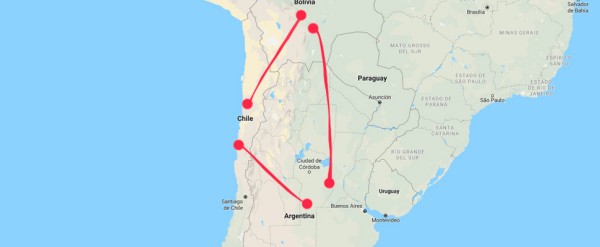About the triangle that will power your next car
Do you already know where it is?
(Just a few factoids that everybody aiming to live “modern, but green” should know)
Lithium is the heart of the batteries that make smartphones, tablets, state-of-the-art weapon systems and electric cars work.
At least half of the world’s reserves of this strategic mineral are in a triangle that goes from the Salar de Uyuni, in Bolivia, to the Atacama desert, in Chile, and continues east to Argentina:

The extraction techniques require large surface evaporative pools and have a high environmental impact due to the consumption of water and the production of toxic chemical waste. Such techniques require huge investments, especially if they have to be done sustainably, in line with the increasingly stringent requirements of car manufacturers - such as Volkswagen, Mercedes-Benz and BMW.
A key point is the consumption of water: in 2021, nearly sixty-five percent of the water in the Atacama Salar is used to extract lithium, which has resulted in the migration of quinoa farmers and llama herders who had lived in the desert for centuries.
At the same time, the demand for lithium may cause CO2 emissions in the various phases of extraction, production, transport and manufacture triple by 2025 and even sixfold by 2030.
This because, in a report last year, the World Bank forecast that the production of key minerals, including lithium, would need to increase by nearly 500% by 2050 to provide components for critical clean energy technologies.
In Chile, the government downplays the consequences of using water in a desert region that is one of the driest places on Earth: “Under environmental laws the brine is considered a mineral, not water, even though it is water with salt. So, when the government says that only 3% of water is used in mining, they are only referring to fresh water.”
Bottom line: as it happens with practically every good these days, the more sustainable car is not an electric car: is the car that you do not buy, or whose purchase you delay as much as you possibly can. Ditto for anything with batteries, of course.
Sources (of both text and images):
Who writes this, why, and how to help
I am Marco Fioretti, tech writer and aspiring polymath doing human-digital research and popularization.
I do it because YOUR civil rights and the quality of YOUR life depend every year more on how software is used AROUND you.
To this end, I have already shared more than a million words on this blog, without any paywall or user tracking, and am sharing the next million through a newsletter, also without any paywall.
The more direct support I get, the more I can continue to inform for free parents, teachers, decision makers, and everybody else who should know more stuff like this. You can support me with paid subscriptions to my newsletter, donations via PayPal (mfioretti@nexaima.net) or LiberaPay, or in any of the other ways listed here.THANKS for your support!